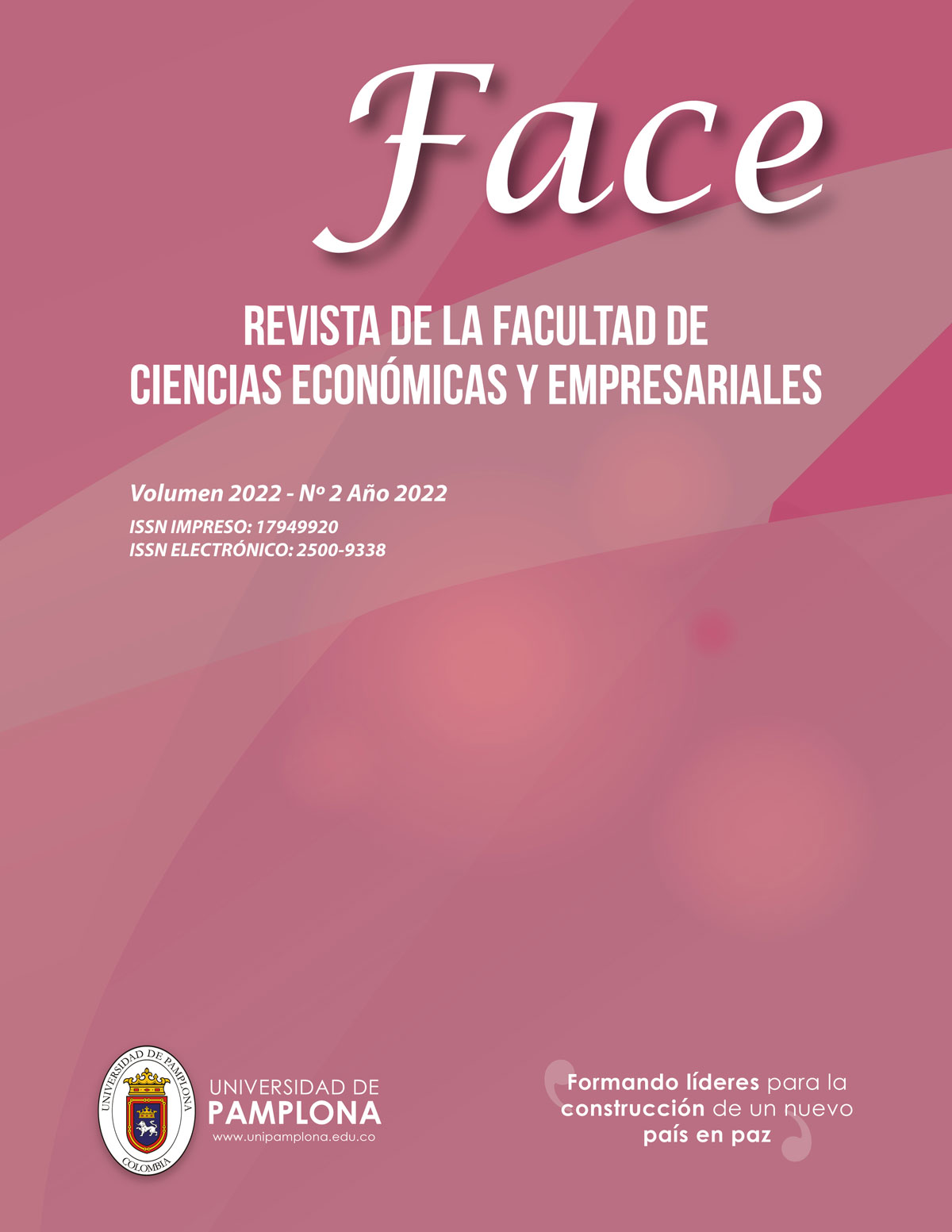CRECIMIENTO ESPIRITUAL, MANEJO DEL ESTRÉS Y COMPLACENCIA PERSONAL DE LOS CONSUMIDORES DURANTE LA PANDEMIA POR EL COVID-19
DOI:
https://doi.org/10.24054/face.v22i2.1336Keywords:
Complacencia Personal, comportamiento del consumidor, compras en línea, COVID-19, Crecimiento Espiritual, Terapia de CompraAbstract
La pandemia por el COVID-19 llegó para modificar los hábitos de compra de los consumidores mexicanos, quienes al
verse limitados a pasar la mayor parte del día encerrados en sus hogares se dieron a la tarea de buscar productos que les permitieran pasar el tiempo de mejor manera. Con el fin de conocer el comportamiento de compra se realizó un
estudio basado en la teoría de autocomplacencia de Mick et al., (1992) con 657 adultos (65.4 % mujeres). Se realizó
un análisis de conglomerados y análisis de factores, obteniendo 3 grupos en función de 2 factores: Crecimiento
Espiritual y Complacencia Personal.
Downloads
References
Adegboyega, A., Boddie, S., Dorvie, H., Bolaji, B. Adedoyin, C. & Moore, S. E. (2020). Social distance impact on church gatherings: Socio-behavioral implications. Journal of Human Behavior in the Social Environment, 31(1-4), 221-234.
Baker, J. O., Martí, G., Braunstein, R., Whitehead, A, L. & Yukich, G. (2020). How COVID-19 Presents New Directions for Research. Sociology of Religion: A Quarterly Review, 81(4), 357-370.
Belk, R. W. (2020). Post-pandemic consumption: portal to a new world?.Cadernos EBAPE. BR,18(3), 639-647.
Bentzen, J. (2020). In Crisis, We Pray: Religiosity and the COVID-19 Pandemic (No. 14824). CEPR Discussion Papers.
Capponi, G., & Araújo, P. C. (2020). Occupying new spaces: the “digital turn” of Afro-Brazilian religions during the COVID-19 outbreak. International Journal of Latin American Religions, 4(2), 250-258.
Clarke, P. D., & Mortimer, G. (2013). Self-gifting guilt: an examination of self-gifting motivations and post-purchase regret.Journal of Consumer Marketing.
Echegaray, F. (2021). What POST-COVID-19 lifestyles may look like? Identifying scenarios and their implications for sustainability.Sustainable Production and Consumption,27, 567-574.
GutCheck. (2015). Healthy Vs. Indulgent Foods: Consumers in The U.S., China, And Brazil Help Us Identify Differences and Similarities Among Countries. (10 de Noviembre del 2015). Recuperada el 02 de abril del 2022 de https://www.gutcheckit.com/blog/healthy-vs-indulgent-foods-consumers-in-the-u-s-china-and-brazil-help-us-identify-differences-and-similarities-among-countries/
Gutiérrez, C. & de la Torre, R. (2020). Covid 19: the pandemic as a catalyst for videograce. Espiral Estudios sobre Estado y Sociedad, 27(78), 167-213.
Hapsari, R., & Ayuni, R. F. (2021). E-tail Therapy during the COVID-19 Pandemic: The Role of Customer Mood Reinforcement on E-tail Loyalty.Global Business & Management Research,13.
Kantar (2020). How people are adapting to life under lockdown. Retrieved from: https://www.kantar.com/inspiration/coronavirus/how-people-are-adapting-to-life-under-lockdown-cn
Koles, B., Wells, V., & Tadajewski, M. (2018). Compensatory consumption and consumer compromises: a state-of-the-art review.Journal of Marketing Management,34(1-2), 96-133.
Konstantopoulou, G., & Raikou, N. (2020). Clinical evaluation of depression in university students during quarantine due to covid-19 pandemic.European Journal of Public Health Studies,3(1).
Kowalczyk, O., Roszkowski, K., Montane, X., Pawliszak, W., Tylkowski, B., & Bajek, A. (2020). Religion and faith perception in a pandemic of COVID-19. Journal of Religion and Health, 59(6), 2671-2677.
Kyrousi, A. G., Zotou, A. Y., & Koronaki, E. (2021). Consumers Under Lockdown: Self-Gifting and Mood Alleviation. InStrategic Innovative Marketing and Tourism in the COVID-19 Era(pp. 39-47). Springer, Cham.
Laato, S., Islam, A. N., Farooq, A., & Dhir, A. (2020). Unusual purchasing behavior during the early stages of the COVID-19 pandemic: The stimulus-organism-response approach.Journal of Retailing and Consumer Services,57, 102224.
Larson, L. R., & Shin, H. (2018). Fear during natural disaster: Its impact on perceptions of shopping convenience and shopping behavior.Services Marketing Quarterly,39(4), 293-309.
Malhotra, N-K. Investigación de Mercados: Conceptos Esenciales. Pearson Educación: Ciudad de México, 2016.
Mick, D. G., DeMoss, M., & Faber, R. J. (1992). A projective study of motivations and meanings of self-gifts: Implications for retail management.Journal of Retailing,68(2), 122.
Polat, S. T., & Uyar, K. (2021). Online retail therapy: Examination of retail therapy levels according to consumers' moods.Turkish Journal of Marketing,6(3), 206.
Resonate (2022). State of the Consumer Report. Recuperado de https://insights.resonate.com/state-of-the-consumer-2022?source=CORP-22-SOTC-WP-PR&Last_Campaign_Form_Fill=CORP-22-SOTC-WP-PR&utm_source=press-release&utm_medium=referral&utm_campaign=CORP-22-SOTC-WP-PR
Yuen, K. F., Wang, X., Ma, F., & Li, K. X. (2020). The psychological causes of panic buying following a health crisis.International journal of environmental research and public health,17(10), 3513.
Zulauf, K., & Wagner, R. (2021). Online shopping therapy: If you want to be happy, shop around.Journal of International Consumer Marketing, 1-14.
Zwanka, R. J., & Buff, C. (2020). COVID-19 Generation: A Conceptual Framework of the Consumer Behavioral Shifts to Be Caused by the COVID-19 Pandemic.Journal of International Consumer Marketing, 1-10.
Downloads
Published
Versions
- 2022-05-27 (5)
- 2022-05-27 (4)
- 2022-05-27 (3)
- 2023-03-22 (2)
- 2022-06-03 (1)
How to Cite
Issue
Section
License
Copyright (c) 2022 FACE: Revista de la Facultad de Ciencias Económicas y Empresariales

This work is licensed under a Creative Commons Attribution-NonCommercial-ShareAlike 4.0 International License.





